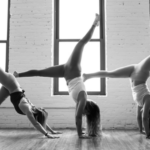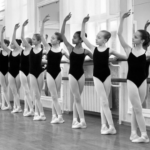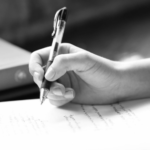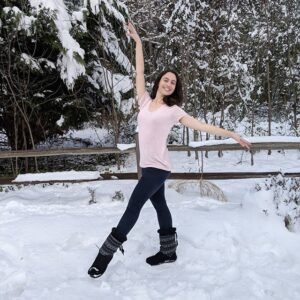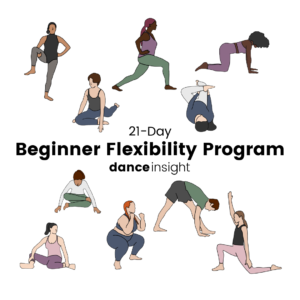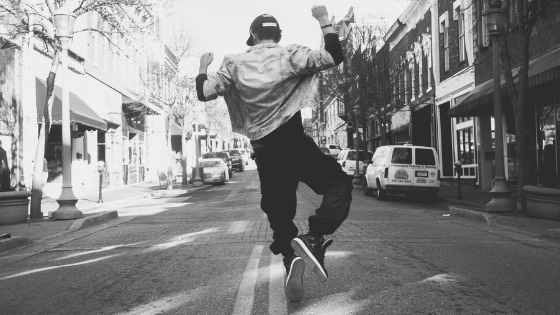
How to Achieve Your Dance Goals in 2018
Let nothing stand in your way
The #1 rule I teach my students is to never say “I can’t.” It’s a terrible habit in all areas of our lives that teaches your brain to limit your potential. How many times have you said “I can’t do [insert trick here],” “I’m really bad at the left side,” or “I could never play that role/earn a spot on that team/get cast by that company”?
Don’t say it. Do not let those words leave your mouth.
But it’s true!
No, let me tell you what you can’t do. You can’t bend your knees backwards. You can’t be in two places at once. You can’t jump up in the air and do a triple backflip without a trampoline. Because… physics. But some people can do their splits and quadruple pirouettes and cartwheels on the left side, so why can’t you?
Okay, maybe you can’t do your splits right now… but it’s the wording that you need to avoid. As soon as the word “can’t” gets applied to something in your life, it becomes an instant roadblock. If you don’t believe me, go look up the power of mental imagery and you’ll see that how you think greatly affects how you move. (Read anything by Eric Franklin for something dance-specific on that topic.) Instead of saying “I can’t,” say something like, “I’m still working on…” “I don’t have it yet,” or “My [whatever] could be better.”
So start eliminating those road blocks in your thinking and set the stage for a 2018 full of achievement!
Now that you’ve got your head in the game, let’s look at some specifics.
Pick specific goals
It’s important to have very specific goals if you want to see real improvement. Why? Because then you’ll be able to measure success. Don’t say something vague like, “I want to get better at pirouettes,” because what does “get better” really mean? Be more specific with your goals, like this:
“By the end of 2018, I will be able to land a triple pirouette cleanly, without hopping, on at least 90% of my attempts.”
That’s called a SMART goal. It’s Specific, Measurable, Attainable, Realistic, and Time-based. With a goal like that, it’s easy to test your progress. Attempt a triple pirouette ten times in a row, and count the number of times you land cleanly without hopping. Your goal is 9/10. As you practice your technique throughout the year, you’ll see that number get closer and closer to your goal, and it will be so satisfying, giving you the motivation to continue!
Unsure of what dance goals you want to set? Check out my other post with 40 ideas for dance-related goals.
Pick several, because 12 months is a long time to work on one goal, and you’ll get it done faster if you have a shorter deadline. Be ambitious, but make sure it’s at least conceivable that you could achieve all of them in a year. You’ll be more prone to giving up if your goals are overwhelming.
Assess the gap
Okay, so you’ve stopped saying “I can’t” and you’ve picked some ambitious dance goals for 2018. Now what? Depending on your goal, it might be easy to see what you need to do to achieve it, or you might have no idea where to start. That’s where assessing the gap comes in.
What’s the gap? It’s the gap between where you are now and where you want to be. Is it a deep chasm that you have to leap over in one swoop, or is it a wide river with a long series of stepping stones? Some goals are simple: just get over your fear and do it. That’s where I am with aerials right now. I know I’m so close and I’ll be fine if I fall, but my body’s protective instincts are understandably wary of flipping upside down with my face two feet from the floor. (An aerial is a cartwheel with no hands.) But once I get over the fear, I’ll be fine. It’s a one-step goal.
Other goals will take much more time, patience, and careful planning. These are the goals that involve building strength, gaining flexibility, improving stamina, things you can’t do overnight. My biggest dance goal for 2018 is to be able to hold my leg at its full extension for at least 10 seconds. That’s a long way off, because my legs are very flexible but very weak. But the good news is it will be easy to measure my progress. First I’ll hold at 45 degrees for 10 seconds, then 90, then 100, and so on.
But maybe you have no idea what your gap is. You want to get better at calypsos, but you can’t tell what the good leapers are doing differently from you. You feel awkward and clunky when you dance, and just want to move gracefully. How do you measure that? Try these tips for figuring out your path to improvement.
Give yourself corrections
Obviously, you should work on your teachers’ corrections, too, but I’m assuming you’re already doing that. And here’s the thing: unless your teacher has magic powers, or you have the privilege of private lessons, you will never get a full assessment of everything you need to do to improve a step. You’ll get one correction, maybe two, whatever the teacher thinks is most important. But chances are she actually saw five or ten corrections that she doesn’t have time to say. You need to be your own private teacher.
But I’m not a dance teacher. How do I give myself corrections?
That could really be a whole post in itself, but here are a few quick tips that I use to give myself corrections:
- Find a video of someone doing it really well. Watch it frame-by-frame by pressing play and then immediately pressing pause. Take a video of yourself doing the same thing and compare.
- Break it down. A leap is not just one movement. There’s the kick, the takeoff, the pose in midair, and the landing. All of those require different skills to improve.
- Be a beginner. Watch a tutorial video about how to do the step you’re working on. You already know how to do it, of course, but being re-taught can give you new insights and maybe remind you of tips you had forgotten.
Make a plan
Once you’ve figured out what you need to work on, it’s time to make a plan and stick to it. This is a plan that you will work on by yourself, outside of class. It doesn’t need to be an hour-long workout, just a regularly-scheduled time to practice your goals.
Can’t I just work on it in class?
If you want to see real improvement in a short amount of time, you cannot rely on class. Even if you have the best teachers in the world, you’ll only spend a short amount of class time working on your goal, and class work is never as effective as individual practice. The time you spend doing combinations and standing around while someone else gets a correction could be spent drilling releve passe in your bedroom, building core strength, and assessing your performance in a video.
I’m not saying that class isn’t important. Class is essential. It’s just not the place to drill your problem areas and give them the extra attention that they need.
How to get stronger
- Figure out exactly which muscle groups need strengthening for your goal. It’s not just “legs.” It’s inner thighs, rotators, hip flexors, hamstrings…
- Work out. Sorry, there’s no easy road here. Pick some exercises for those muscles, make a schedule, and do some reps. Challenge yourself to do more every time. Make yourself sore.
- Eat protein. Your body can’t build muscle without protein. And if it’s not building muscle, all your workouts are for nothing.
How to get more flexible
- Stretch. Should be a no-brainer, right? But how you stretch is important.
- Hold stretches for 30 seconds to 2 minutes. Breathe deeply and try to relax.
- Make sure the stretch you’ve chosen mimics the skill you’re working on. If your hips are supposed to be square in the skill, make sure your hips are square in the stretch.
- Try dynamic stretching, where you don’t just sit and hold a stretch, but move through it. Research is starting to show that this is better for your body than static stretching. An example of a dynamic stretch is lying on your back and doing repetitive battements.
How to be more graceful or coordinated
Have you ever watched a baby walk? Aside from being cute, it’s fascinating to watch from a movement perspective. They lean forward, pick their feet up really high, and clomp along with an awkward gait. They’ve only been walking for a few months, and it’s a lot to get used to.
Don’t you walk much more gracefully than a baby? You glide effortlessly from one foot to another, even on uneven ground, without even thinking about it. Why? Because you’ve walked millions and millions of steps in your life, and it’s second nature.
Unfortunately, that’s the answer to the question of “how do I become graceful/coordinated?” There’s no quick fix. You just have to dance a lot. The more you do it, the more your body will grow accustomed to it. You can speed up the process by taking more classes or practicing at home by learning combos from YouTube videos, but grace will come with time.
Keep records of your progress
As you progress towards your goal, you will inevitably experience times of doubt, apathy, and frustration. No matter how enthusiastic you are now, you will want to give up later down the road. One of the best safeguards I can think of against this is keeping records your progress. When you look back at the first day and see how far you’ve already come, it will help you stay motivated to go even farther.
A great place to do this is in your dance journal. You don’t need to write long entries every day, just make little notes about what you did, how many reps, any new corrections you got, whatever you feel is important. Check out this post to help you get started keeping a dance journal.
What are your dance goals for 2018? Leave a comment below and I’ll try to write a post for your specific goal this year!



